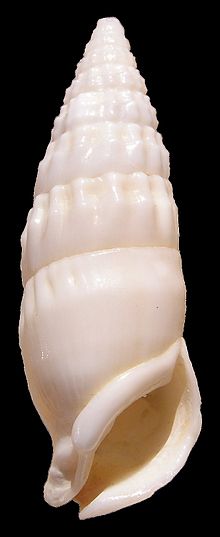Cerithiidae
| Cerithiidae | |
|---|---|

| |
| Apertural view of a shell of Rhinoclavis vertagus. | |
| Scientific classification | |
| Domain: | Eukaryota |
| Kingdom: | Animalia |
| Phylum: | Mollusca |
| Class: | Gastropoda |
| Subclass: | Caenogastropoda |
| Superfamily: | Cerithioidea |
| Family: | Cerithiidae Fleming, 1822[1] |
| Diversity[2] | |
| 71 extant species of Bittiinae | |

Cerithiidae,
Distribution
Ceriths are found worldwide on
are found in deep water.Diet
Ceriths are
Description
Their slender
The many whorls have radial sculpture with axial ridges and nodules. The aperture shows at its base a vague curve or a distinct siphonal canal. The aperture is closed off by a thin oval brown operculum that is corneous and paucispiral. The palatal wall of the aperture is somewhat enlarged and often shows a varix.
The taenioglossan radula has seven teeth in each row. The single rachidian tooth is flanked on each side by one rhomboidal lateral tooth and two long, hook-like marginal teeth.
Taonomy
Subfamilies
The following three subfamilies have been recognized in the taxonomy of Bouchet & Rocroi (2005):[3]
- Dall, 1927
- Bittiinae Cossmann, 1906[4]
- Cerithiinae Fleming, 1822 - synonyms: Rhinoclavinae Gründel, 1982; Colininae Golikov & Starobogatov, 1987
Bandel (2006)[5] used different classification: Bittiinae on its own family level named Diastomatidae (overview of WoRMS).
Some authors classify Argyropezinae Bandel, 2006 as a synonym of Bittiinae.[6]
Genera
The following genera are recognised in the family Cerithiidae:[7]
- Alabina Dall, 1902 - type genus of the subfamily Alabininae, the type species of the genus Alabina is extinct[3]
- Argyropeza Melvill & Standen, 1901
- †Bezanconia P. Fischer, 1884
- Bittiolum Cossmann, 1906
- Bittium J. E. Gray, 1847 - type genus of the subfamily Bittiinae,[3]
- †Bogatschevia A. A. Ali-Zade & Kabakova, 1969
- Cacozeliana Strand, 1928
- Cassiella Gofas, 1987
- †Cerithidella Stache, 1889
- Cerithidium Monterosato, 1884
- Cerithioclava Olsson & Harbison, 1953
- Cerithium Bruguière, 1789 - type genus of the subfamily Cerithiinae,[3]
- †Chavanicerithium Ludbrook, 1957
- Clavocerithium Cossmann, 1920
- Clypeomorus Jousseaume, 1888
- Colina H. Adams & A. Adams, 1854
- †Conocerithium Sacco, 1895
- Dahlakia H. E. J. Biggs, 1971
- Fastigiella Reeve, 1848
- †Globulocerithium Pacaud, 2023
- Glyptozaria Iredale, 1924
- Gourmya P. Fischer, 1884
- Ittibittium Houbrick, 1993
- †Jetwoodsia Ludbrook, 1971
- Limatium E. E. Strong & Bouchet, 2018
- Liocerithium Tryon, 1887
- Lirobittium Bartsch, 1911
- †Manulona Ludbrook, 1941
- †Megistocerithium Kase, 2015
- †Mesostomella Stache, 1889
- Neostylidium Doweld, 2013
- †Occidentocerithium Nützel, Blodgett & Stanley, 2003
- †Orthochetus Cossmann, 1889
- †Peraubium Dominici & Kowalke, 2014
- Pictorium E. E. Strong & Bouchet, 2013
- †Pseudoaluco B. L. Clark, 1946
- Pseudovertagus Vignal, 1904
- †Ptychocerithium Sacco, 1895
- Rhinoclavis Swainson, 1840
- Royella Iredale, 1912
- †Semibittium Cossmann, 1896
- †Taxonia H. J. Finlay, 1926
- †Texmelanatria K. van W. Palmer, 1942
- Varicopeza Gründel, 1976
- Zebittium H. J. Finlay, 1926
- †Zefallacia H. J. Finlay, 1926
References
- ^ Fleming, John (1822). The philosophy of zoology 2: 491.
- .
- ^ ISSN 0076-2997.
- ^ Cossmann (1906). Essais de paléoconchologie comparée 7: 64, 137.
- ^ Bandel K. (2006). "Families of the Cerithioidea and related superfamilies (Palaeo-Caenogastropoda; Mollusca) from the Triassic to the Recent characterized by protoconch morphology - including the description of new taxa". Freiberger Forschungshefte C 511: 59-138. PDF[permanent dead link].
- ^ Gofas, S. (2011). Bittiinae. Accessed through: World Register of Marine Species at http://www.marinespecies.org/aphia.php?p=taxdetails&id=411649 on 2011-06-26
- ^ "WoRMS - World Register of Marine Species - Cerithiidae J. Fleming, 1822". www.marinespecies.org. Retrieved 2024-04-24.
This article includes a list of general references, but it lacks sufficient corresponding inline citations. (June 2011) |
- Houbrick R. S. (1978). The family Cerithiidae in the Indo-Pacific. Part 1. The genera Rhinoclavis, Pseudovertagus and Clavocerithium. Monographs of Marine Mollusca 1: 1–130.
- Houbrick R. S. (1992). Monograph of the genus Cerithium Bruguiere in the Indo-Pacific (Cerithiidae--Prosobranchia). 211 p., Smithsonian Institution Press (Washington, D.C.)], PDF.
- Wood, Elvira. The Phylogeny of Certain Cerithidae, Annals of the New York Academy of Sciences, Volume XXIV, New York, May 1910, pp. 1–92, Pl. I-IX.
External links
- Miocene Gastropods and Biostratigraphy of the Kern River Area, California; United States Geological Survey Professional Paper 642
 This article incorporates text from this source, which is in the public domain.
This article incorporates text from this source, which is in the public domain. - Houbrick, Richard S. "Phylogenetic relationships and generic review of the Bittiinae (Prosobranchia: Cerithioidea)." Malacologia (1993).
 Media related to Cerithiidae at Wikimedia Commons
Media related to Cerithiidae at Wikimedia Commons
